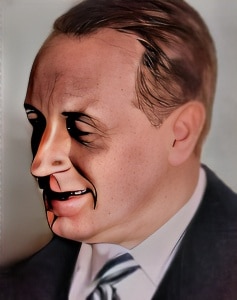 Al St. John, born on September 10, 1892, in Santa Ana, California, was a versatile actor who made significant contributions to the early years of American cinema.
Al St. John, born on September 10, 1892, in Santa Ana, California, was a versatile actor who made significant contributions to the early years of American cinema.
His career spanned the silent film era and the transition to sound films, showcasing his adaptability and talent as an actor.
During the early 20th century, the film industry was still in its infancy, and silent films were the dominant medium. Silent film actors had the unique challenge of conveying emotions and narratives primarily through facial expressions and physical movements. Al St. John excelled in this art, demonstrating his ability to engage with audiences through nonverbal acting.
One of the remarkable aspects of Al St. John’s career was his association with comedy legend Mack Sennett and his work at the Keystone Studios. St. John, the nephew of Roscoe “Fatty” Arbuckle, was part of the renowned Keystone Cops, a group of bumbling and slapstick policemen who appeared in numerous silent comedies. His role in this ensemble showcased his talent for physical comedy and his ability to engage with chaotic and humorous situations.
St. John’s partnership with Roscoe Arbuckle also led to memorable collaborations, including appearances in Arbuckle’s silent films. The two shared a natural comedic chemistry that resonated with audiences and contributed to the success of their films.
One of the significant works from this collaboration was “Fatty and Mabel Adrift” (1916), directed by Roscoe Arbuckle and co-starring Mabel Normand. This silent comedy film displayed St. John’s ability to infuse humor into every scene, making it a memorable addition to the silent film era.
Additionally, Al St. John’s adaptability extended beyond his comedic roles. He was known for his versatility, appearing in a variety of silent films, including Westerns, dramas, and character-driven roles. His filmography showcased his ability to engage with a diverse range of characters and narratives, highlighting his dedication to his craft.
The transition to sound films marked a significant shift in the film industry, challenging many silent film actors to adapt to this new era. Al St. John’s adaptability allowed him to navigate this transition successfully, emphasizing his commitment to his craft. He continued to find work in the evolving world of cinema, demonstrating his resilience and talent.
While his name may not be as widely recognized today as some of the leading actors of his time, Al St. John’s contributions to early cinema remain a testament to his talent and dedication as an actor. His work in the silent film era, his collaborations with comedic legends, and his successful transition to sound films underscore his versatility and enduring presence in the world of cinema.
In conclusion, Al St. John was a versatile actor of the silent film era who made significant contributions to the early years of American cinema. His association with comedy legends, his role in the Keystone Cops, and his ability to engage with a wide range of characters and genres highlighted his talent and dedication. While his name may not be as widely recognized today, his performances and contributions to the art of storytelling continue to be celebrated as an integral part of the rich history of early Hollywood.
Loading live eBay listings...




